December 2018 - January 2019
"We wanted to be sure you were alive"
Our return to a favorite wild camp site was not without its bit of drama
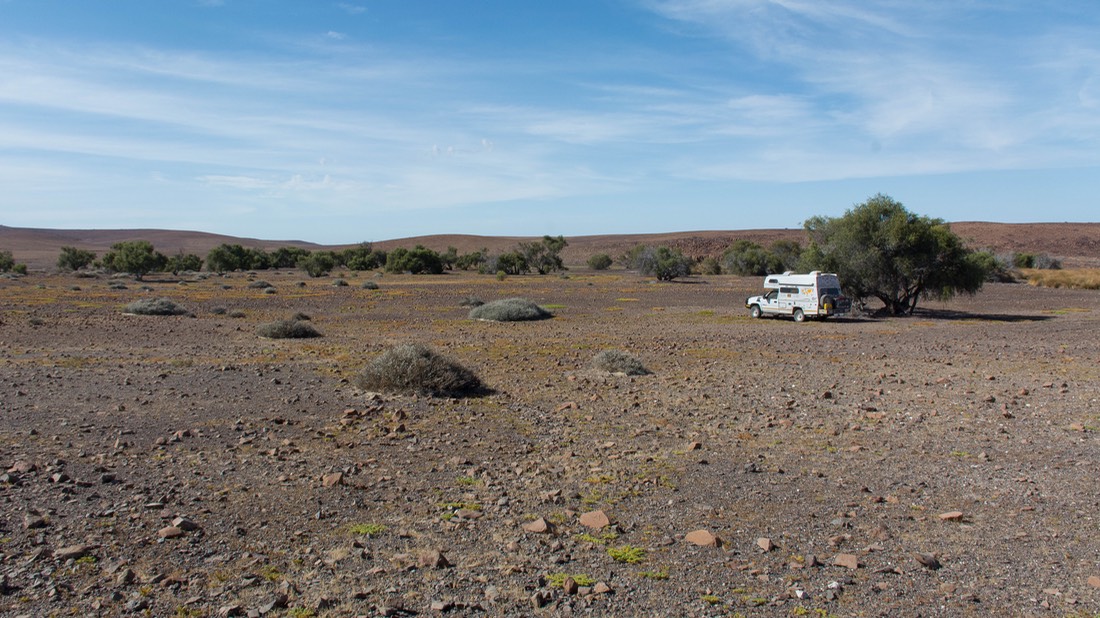
We were sitting out in the wilderness of the Torra Conservancy enjoying our second visit to this site, watching oryx and ostriches in the distance, listening to the chatter of the birds flying back and forth among the trees, and murmuring that the jackals we’d seen on our first stop here had wandered back through last evening. As we enjoyed the day, we watched a truck approaching in the distance. We knew we were in a place where it was legal to wild camp, where there shouldn’t be trouble, but you get concerned in any case.
The truck pulled up; white, with a Namibia Wildlife logo on the side. Out stepped this very nice middle-aged man, a younger couple, and a small boy. The older man introduced himself as MET (Ministry of Environment and Tourism), commented that the other two adults were state police, and “This is my grandson.” It was New Year’s Day, they were out for a ride checking on the wildlife, “there are baby oryx to the north a bit… and lots of lions and elephants in the area”, and gathering a bit of firewood. From a distance our truck appeared deserted, and they wanted to make sure we were all right.
After a brief chat, and a discussion of where we were heading, we all agreed it was a beautiful day in a lovely part of Namibia; they hopped back in their truck and went on their way. A great start to 2019.
* * * * * * *
As you’ve figured out by now, we are making Namibia work for us by fleeing to the coast from time to time in order to cool off. Early in December, our last visit to the salty sands ended with us spending some time driving along the Skeleton Coast, where we visited the seal colony at Cape Cross. The Skeleton Coast is known for its… well… skeletons. Back in ancient times, they were the remains of various sea animals — mostly whalebones; but starting in the 1500s the area became known for the many wrecks of ships that smashed themselves up along the difficult coastline, and the skeletons of shipwrecked crew members. It’s a nice enough area, although these days almost all the remains are in the far northern part of the park, which is not accessible to casual travelers, but only those on organized tours.
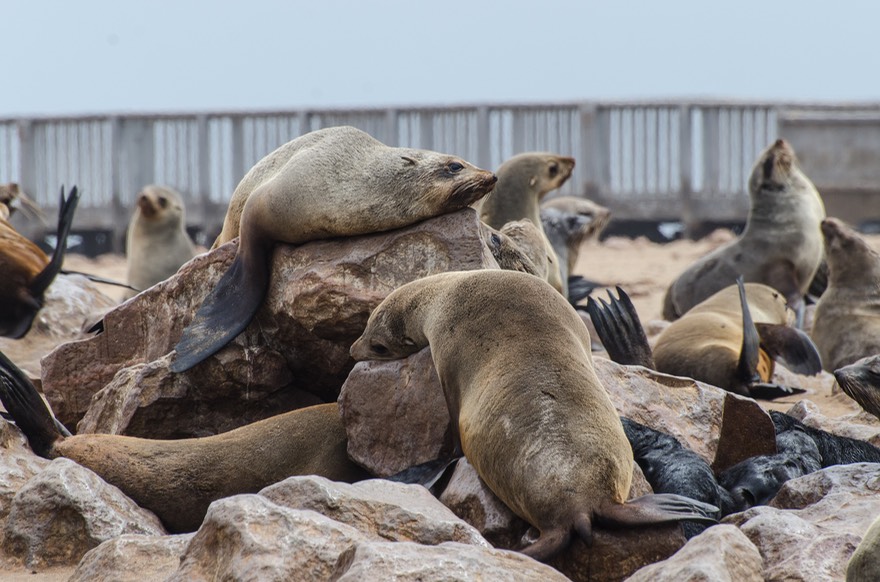
Cape Cross itself is so named for the double cross planted on the bluff by Diego Cão, the Portuguese explorer who landed here in 1484; he was the first European to visit this coast, having been sent to claim the spot for the King of Portugal. The crosses now (there are two of them) are replicas, but there are also a couple of monuments commemorating the occasion. They are right next to the fur seals.
These days most folks come to this area for one of three reasons — the fishing is supposed to be stupendous, the Cape Cross Lodge makes a terrific spot for anyone with romantic inklings (i.e., there’s absolutely nothing here but fish and beaches and a lovely lodge to cozy down in); or, they think that Cape fur seals are pretty nifty and they come to enjoy the noise and stench and adorable pups. Both times we’ve been to Cape Cross we have stayed at the lodge’s campsite, and there were more fishermen on hand than other travelers, all keeping an eye on tide tables and heading out long before dawn to get to “their” spot at the perfect moment.
The best fish and chips in the area were to be found down on the strand in Swakopmund, but at Cape Cross we loved the atmosphere, and the nearby (but down-wind) seals were both outrageous and splendid. By the way, the Cape Cross Lodge makes its own bread, and it is out of this world.
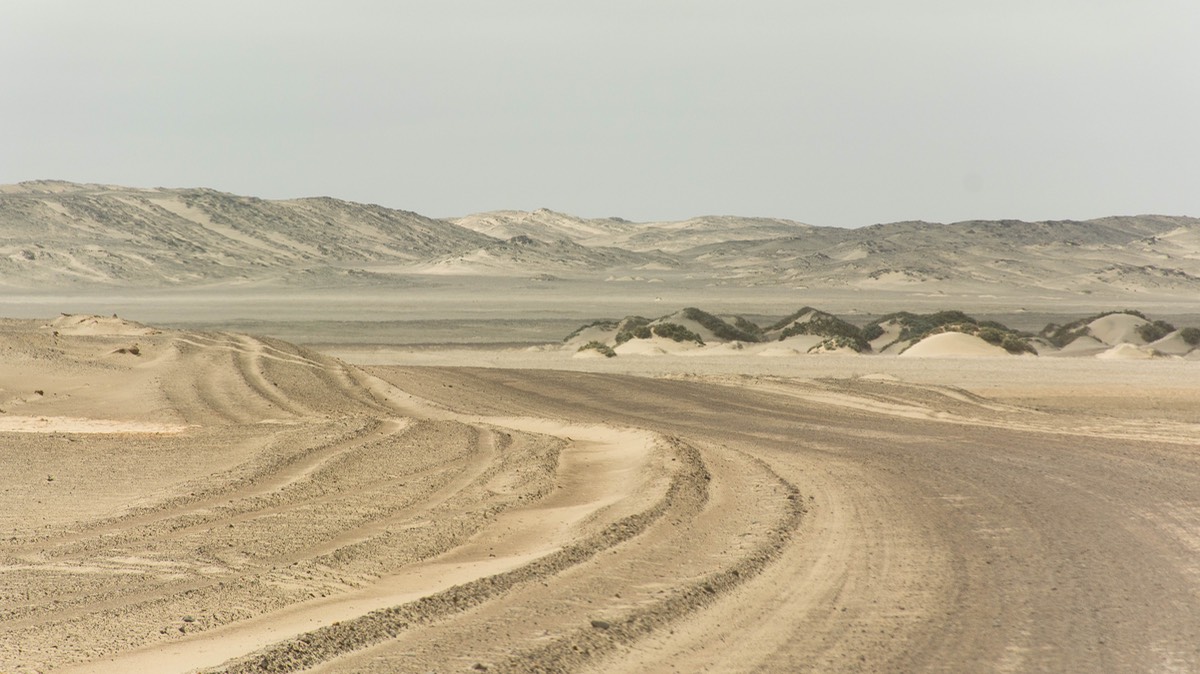
Finally deciding we should leave the coast and get on with our exploration of Namibia, we spent the rest of December in the area north and west of Etosha NP (where we’d already been) roughly referred to as the hinterlands, or more officially Kaokoland. We wanted to explore some of this, the most remote part of the country. Our northern destination was to be Epupa Falls, on the Kunene River, right on the border with Angola.
Our planned route was to start with a wander through the Torra Conservancy, then up through Palmwag and Opuwo and Okangwati, on to Epupa Falls, then turn east on a famous (but not necessarily impossible) 4x4 track along the river to where it rejoins the rest of the world at Ruacana Falls. At that point we would see how we were doing and plan the rest of our “free time” before about January 7. At that point we need to be back in Windhoek to arrange various things so we can leave mid-month for a short visit back home.
You reach the Torra Conservancy by driving north through the Skeleton Coast National Park. The road goes along the water some of the time, rather nice in early morning mists, but more often just piles of dirt interspersed with a few plants. There’s lichen along here that brightens in the morning damp then subsides back into dullness. As you can tell, not all that much to recommend it. But if you sit back and just take it all in, there are many lovely moments — the sand dunes and ridges and various kinds of rocks all have their charm — and there are roadside stands with rose quartz in all sorts of sizes on offer.
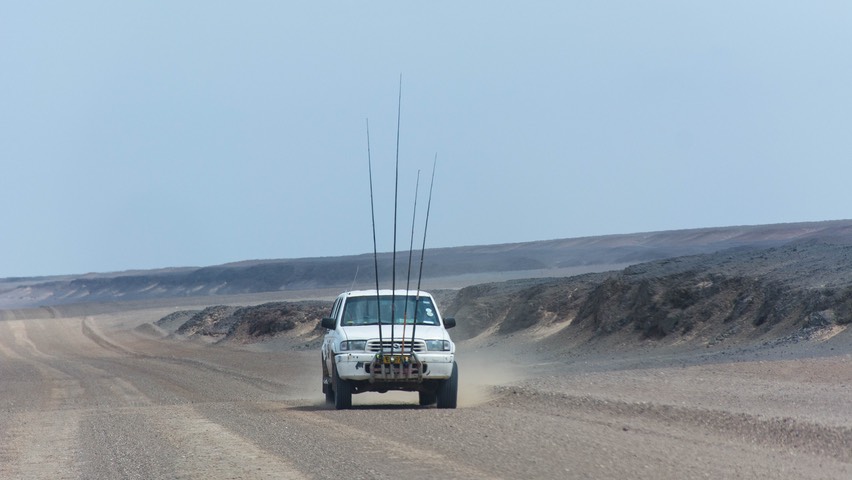
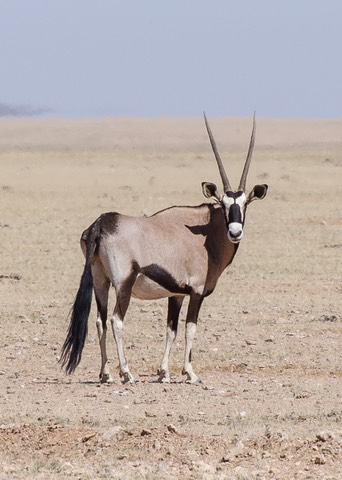
We were quite interested in the numerous trucks that we encountered along the way; we could tell they were fishermen because of the array of enormous poles sticking up out of holders attached to the front bumpers. The long skinny poles reminded us of the antlers of one of our favorite animals, the oryx. We called them Faux-Oryx, or Foryxes. (Howe Humor at its best, sorry to say.)
At Torra Bay the road turns inland and immediately becomes prettier as it heads up toward the exit from the park, taking you to the western edge of the Conservancy. By the time you arrive at the gate you have reached about 500 meters in elevation and are starting to enter a lovely piece of this world.
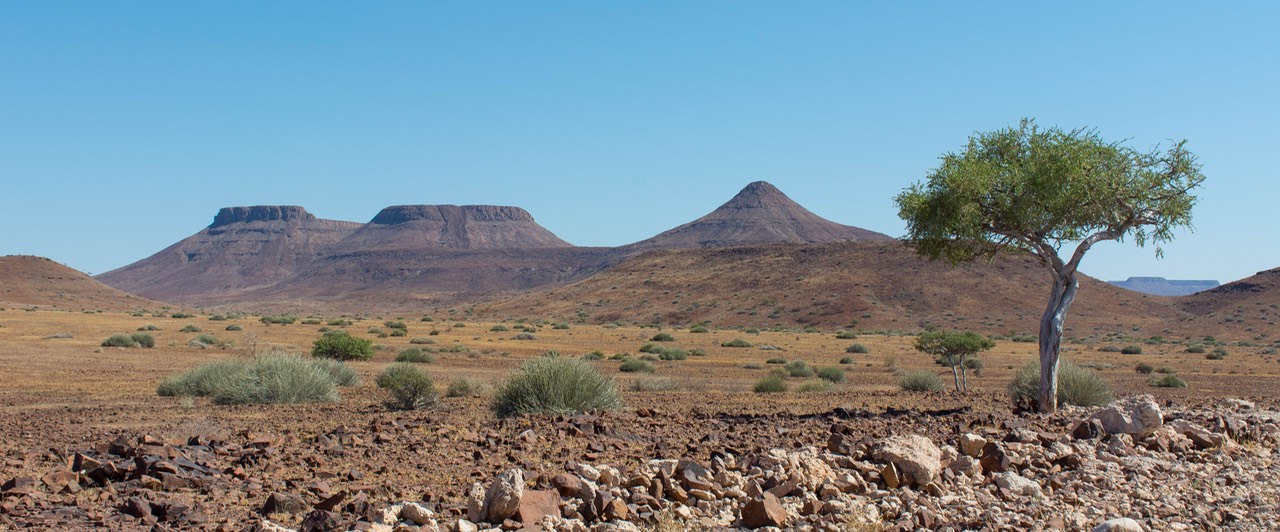
We really enjoyed driving through the Conservancy; wild camping is legal and we found a very nice spot to sit and look around for a couple of days as shown in the top photo. The air was warmer than right on the coast, but the breeze was blowing in from the sea, keeping it much cooler than it would be further inland. We saw hyenas and jackals, springbok, lots of summer desert plants, shared our spot with birds in nearby trees, and really were rather delighted.
We’ve really missed wild camping since arriving in Africa, as it just isn’t considered wise in many areas. Here we were alone at last, and we were very happy.
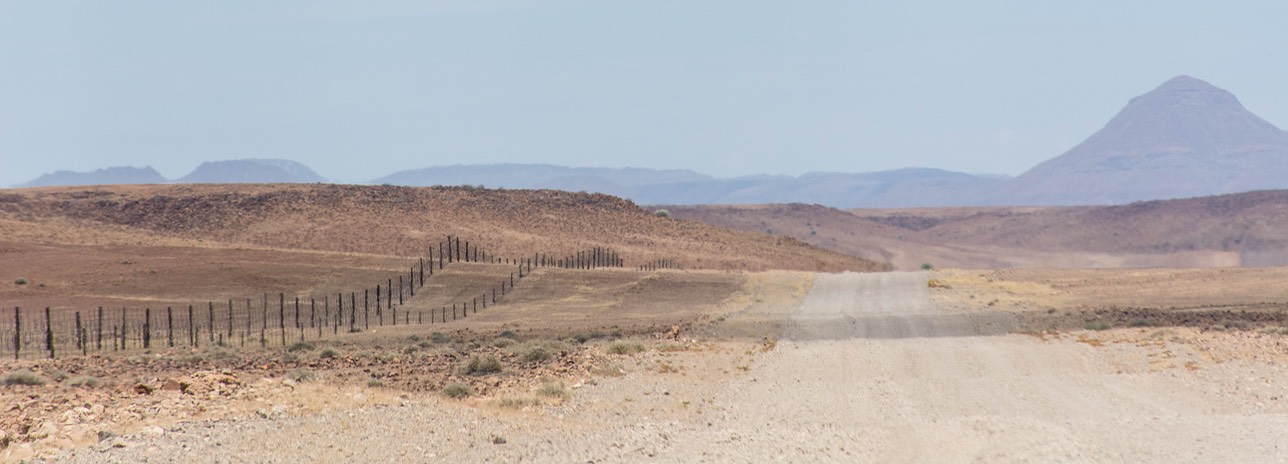
Much of the time, the northern edge of the Conservancy runs along what is often referred to as the Vet Fence, aka the Rooilyn Veterinary Fence. This barrier runs completely across Namibia (and Botswana as well, it appears). It’s to keep animals from coming south, and people from bringing the wrong food south with them. It’s all about hoof-and-mouth disease. We just took note at this point, as they don’t care what goes north, but knew we’d be back at some future moment, heading toward Windhoek. Turning north, we passed through; they paid no attention to us, waving us on.
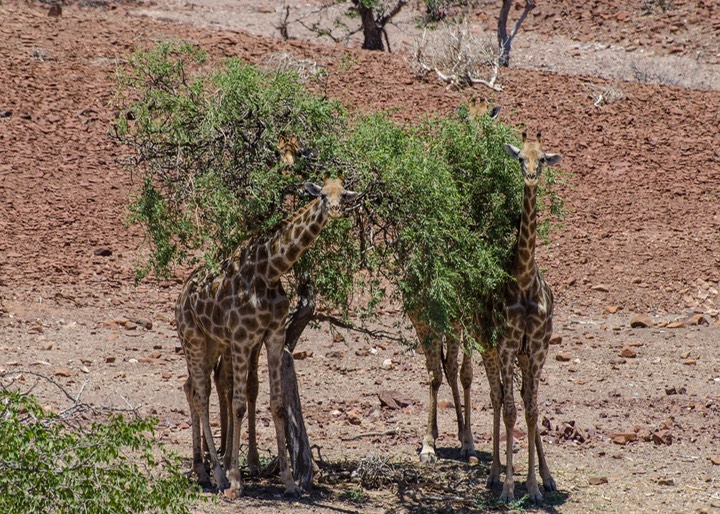
We headed up through Palmwag, part of a large rural area that is known to be home to desert-adapted elephants. We saw Alert signs along the road saying to be aware, and then actual signs in the form of elephant dung, and then got really lucky. They weren’t close, just on the far hillside, but there were about a dozen of them and we were able to see them quite well. We were pleased. Probably not all that big a deal to you, but we take our pleasures where we find them! Nearby we also came across some giraffe munching on the trees.
Pleasure soon turned to frustration — ssssssssssss became a flat tire on this rocky road. Rick got out to assess the damage and change to the spare.
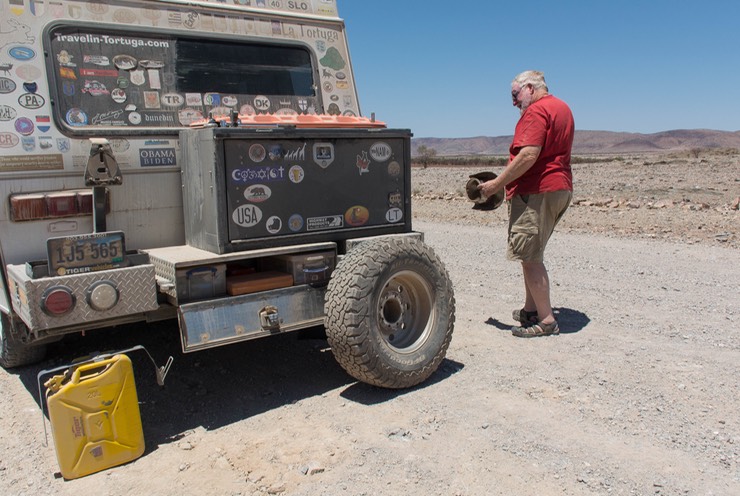
Spread out on the ground, with his head underneath the truck’s carriage, there suddenly was a lovely British voice with a German accent —
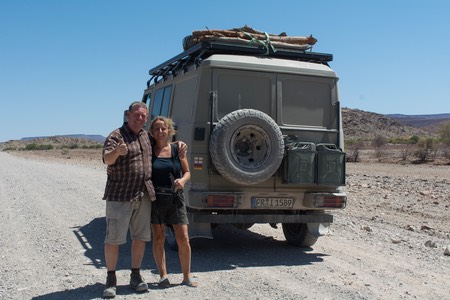
“Can I give you a hand there?” David and Sigrid Hucklesby are folks out in their overlander rig. He’s English, she’s German, and they were just great. They stopped and chatted, and David took up the task of getting us back on the road. It was delightful. We’ll hope to run into them again somewhere and return the favor.
These days we are traveling with a single spare. We had two in Latin America, but didn’t bother in Europe, and with trying to lighten our load these days, had decided not to add a second one back in. This situation is now under reconsideration, with Rick working on a plan for how we can manage to have that second spare in case we need it. Stay tuned.
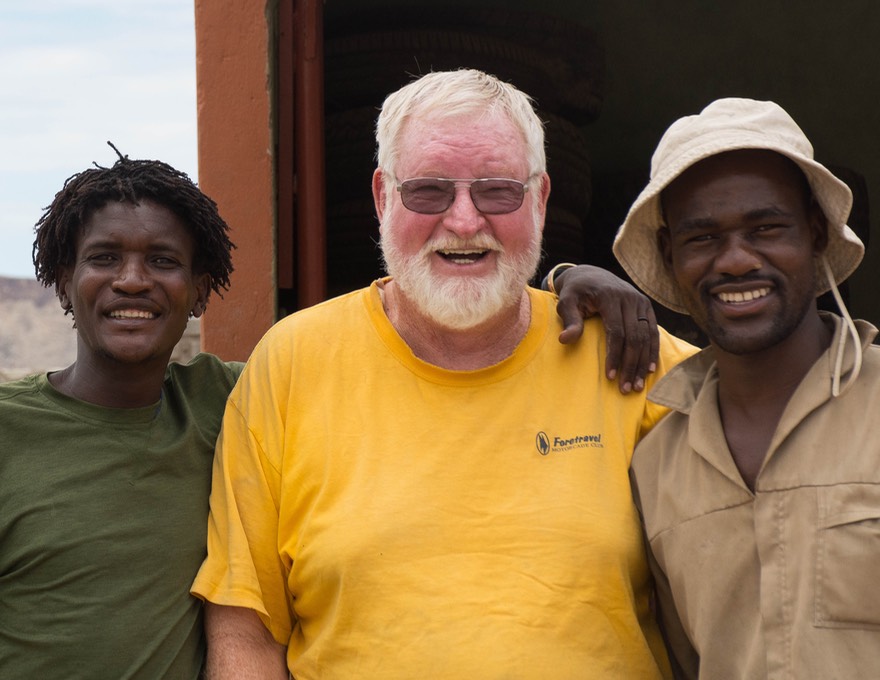
We now needed to get the damaged tire patched, and the first opportunity would be in Sesfontein, maybe 75 kms further up the road. We decided to forego a couple of off-road sightseeing opportunities in between (a gorge and some falls) and to head to Sesfontein the next day. These are very small villages we’re talking about here and Rick was concerned about whether we’d find a shop with an actual tire machine as opposed to guys using hammers to get the tire off the wheel. So we cruised slowly through Sesfontein and were happy to spot one tire shop with the right equipment. Well! The Sesfontein tire guy is brilliant, delightful, easy-going, and quite competent. His shop is a little shelter next to the “tourist info” place (hah!), happy to help and quickly did a good job for us while confirming that yes, he has the only tire machine in the area.
Back on the road we continued on up through Damaraland (home of the Damara people) and into Kaokoland, sort of a general term for the entire northwestern part of Namibia. It’s rural, remote, very dry mostly but quite lovely in places and home to a high proportion of the native groups in the country. The most famous of these groups are the Herero and Himba; more on them later. The roads are pretty bad, so you take it slowly and watch for the goats and occasional cattle wandering the roads.
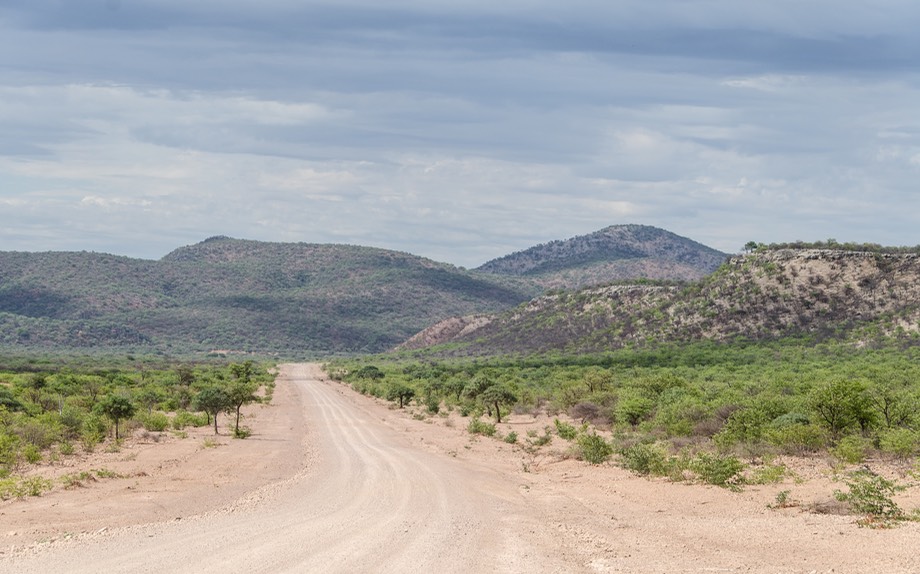
We stopped in Opuwo to shop. Our guidebook refers to it as a “frontier town” — a bit rough, full of seemingly happy, smiling folks, lots of bars and music, a couple of stores and fuel stations, and not too much else. There were a lot of people in and around the stores and for the first time in Namibia we felt uncomfortable leaving the truck. So, we took turns with one of us staying to keep an eye on things while the other shopped or ran other errands. This is the last real town (and shopping) for many a kilometer, so we stocked up before moving on. About 40 kms up the road we found a really nice little campsite for the night.
Namibia has lots of small community campsites, run by local people; low-key, with nice facilities and well-maintained sites, and often with interesting things nearby. The Omungunda Campsite was next to the Ohandungu Living Museum, with local artifacts, and also featured a bush walk to see some rock carvings. In cooler weather we would have enjoyed taking advantage of all these offerings, but today it was too hot.
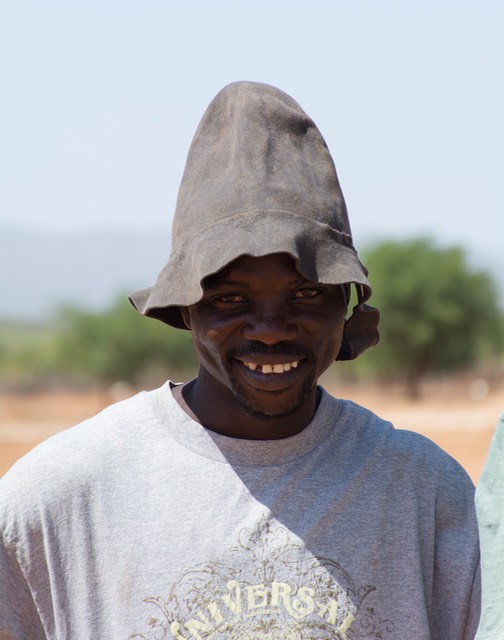
We just stayed the one night but the moon that night was incredible. It was December 21 — either the shortest or the longest night of the year, depending on where you were. The moon was close, huge, and very bright in a clear-clear sky.
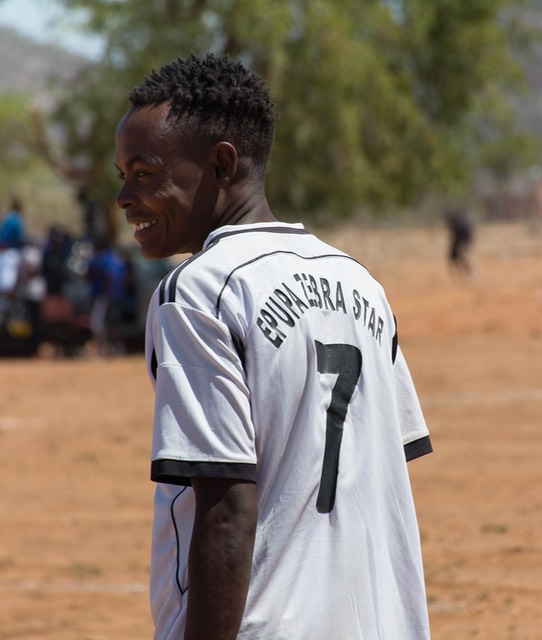
One opportunity we didn’t miss was accepting an invitation, given by the friendly camp manager, Saratier, to join him the next morning at the local soccer field about 10 kms on up the road. It seems there was a huge match going to be happening (it was a Saturday, in case you had any doubts!), and he was involved with his local team (his “Himba team”) that would be leading off the play. Well, we sure couldn’t miss that!
It turns out his team is the Epupa Zebra Stars. We hung around for a couple of hours, watching all the fun as the teams gathered, the field marked off for play and the nets strung, the teenage girls strutted, the guys sat in or on top of their cars waiting for the action, and then, about 11:30 they finally gathered for the first round. Saratier told us that even at this point some teams hadn’t arrived yet. They were coming from the Caprivi Strip, the Sesfontein area (we had made a contribution to that local team while having our tire repaired), and even further afield — from all over northern Namibia it seems, and coming a long day’s drive to join in. It was a really big event.
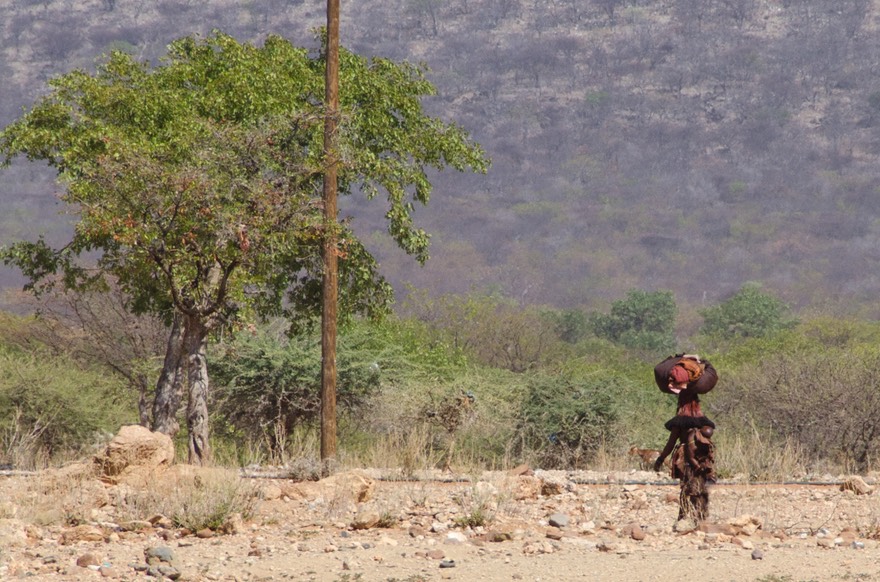
Eventually we had to move on. We needed to get to Epupa Falls, up on the border, and still had a long distance to go on a pretty crummy road. We wished the Zebras all the luck in the world, exchanged hugs with Saratier, and moved along.
By now we were seeing few cattle; it was mostly just goats — and local donkeys; there were lots of kraals scattered around. A few hours later, we were seeing baobab trees, crossing endless dry stream beds, and spotting an occasional baboon. Not much else going on up here.
One reason travelers come into this area is to have the chance to see the Himba people in their rural setting. Historically, the Himba are a very proud people who have kept themselves apart, maintained their ancient traditions, and are rather exotic in appearance. In order to see them in their communities, we’d been told, you need to arrange for a guide, and go with that individual out into a remote area where you could have a chance to interact and learn about their lives and their ways.
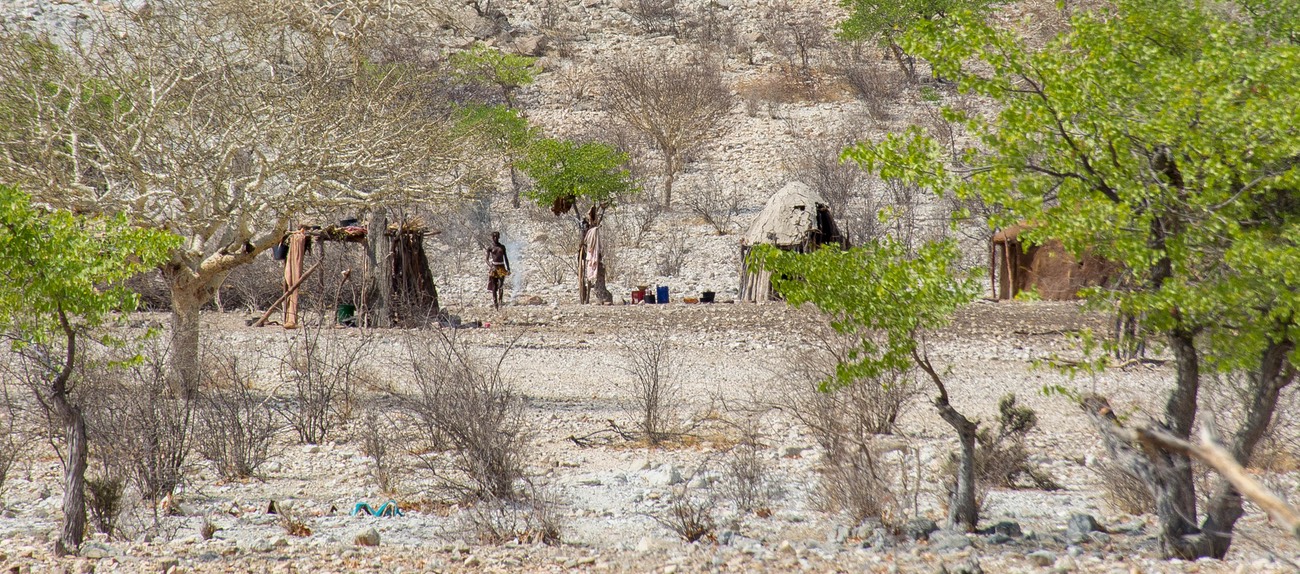
The women are a big part of the attraction. They anoint themselves in a red ochre, plait their hair in very striking and exotic ways, wear beads and skirts of (often) animal skins, and not much else. They are said to be very shy, and don’t wish to be photographed full-face, but will relax a bit after some food and money are proffered.
We really wanted to do this; several people had said it was quite special and something they remembered very well many years later. But for us it did not happen. We had intended to make the contact while we were at Epupa Falls, but by the time we arrived there we’d had several discouraging experiences.
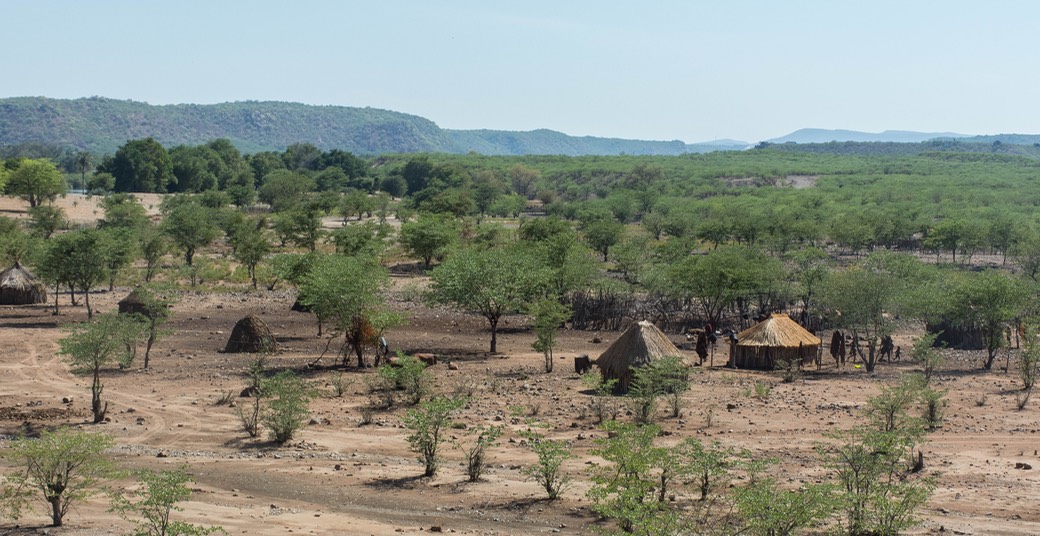
It seemed in our small experience that perhaps already too much of the rest of the world had intruded into the Himba world, and that they were adapting “our” ways — there were lots of women and children begging along the road, the women often with a baby in their arms or posing for a portrait. As adventure tourism has grown and tourist traffic on these small remote roads has increased, we think that perhaps much of the specialness of an encounter with native cultures has been lost? For me, I lost interest after two Himba women came up to me in a grocery store and were determined that I buy them a roast chicken at the deli counter, which I did, but the experience left me discouraged about the mystique of seeing a Himba village.
Aside from this incident, our time in the far north was lovely. The area is very remote. Some of the peaks and valleys that overlanders enjoy so much were beyond our comfort zone (Van Zyl’s Pass for one, all you veteran travelers that are reading this), so we had to pick our route a bit carefully. For instance, we knew of folks who had spent considerable time in the dry river beds heading inland into the hills east of the coast — seeing elephants and other beasties who are adapted for those dry conditions. But dry river beds — filled with large rocks, deep sand and low hanging branches — are not our forté. So we picked a path that kept us happier. It was plenty remote, we traveled through a very nice area, and the route was challenging enough, wandering up through the small village of Okangwati before finally reaching Epupa Falls.
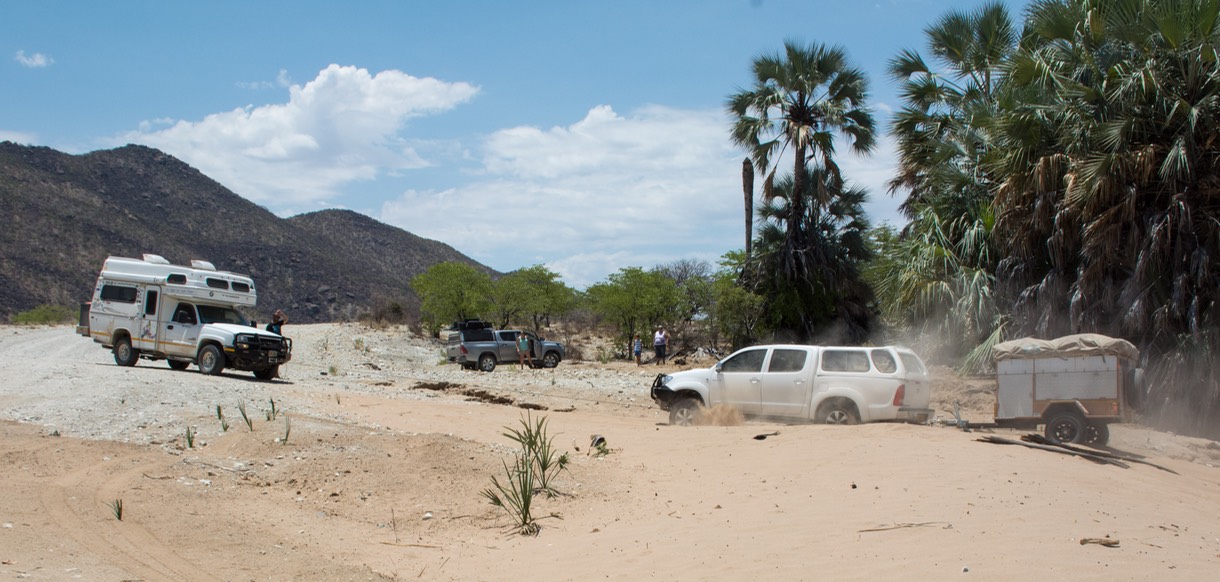
Before reaching the Falls, we came around a corner and encountered one of the reasons why we were being careful in our route choices. One fellow, pulling a trailer, was stuck in deep sand, trying to make it up a rise while crossing a dry river bed. Another fellow and family, in a 4x4 truck, was parked nearby trying to get enough dried palm fronds laid down in a track so he could make a route up the rise for himself and then perhaps find a way to assist. Then we arrived, with our bigger truck and our winch and everyone relaxed. We quite easily pulled out the stuck one, helped the others get settled, and then we all went on our merry way with Tiger throwing sand in various directions as he crossed the stream bed himself. Part of the deal when you drive these roads is you never abandon someone in trouble. Other overlanders helped us with our flat tire and we got to help someone else out of a very bad situation. So we got to say — “Tiger Tugged ‘em Out.” Cool. Most 4x4 travelers agree that a winch may seldom rescue you — because a sturdy enough tree is seldom properly placed — but can be a great help to others in need; as was the case here.
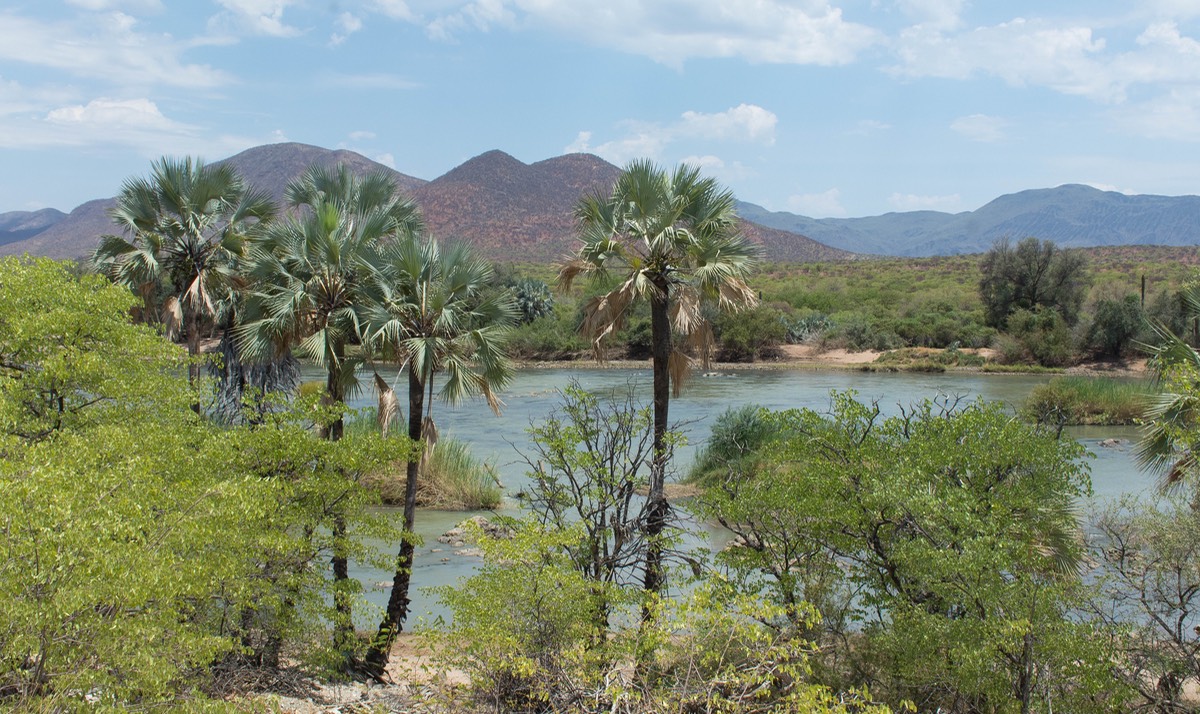
Epupa Falls was just great. Suddenly we’d gotten into the “tropics.” Lots of palm trees, monkeys, higher humidity, and afternoon thunderstorms presaged by high winds that made huge palm fronds come crashing to the ground. We stayed on the “grounds” of the rough lodge that’s there, right on the banks of the Kunene River and overlooking the falls. It was the winter holidays, and the site was rather full, but they made room for us. We joined a group of 8-10 Swiss fellows touring on motorbikes, families out for the holidays, and several groups who’d paused for a hot shower and a meal cooked by someone else — anybody, just as long as it was someone else! And right there, just across the river, was Angola — we waved.
We stayed for a couple of days, meeting other overlanding types and exchanging ideas of what was or wasn’t worth the bother to go see, both further north into other countries and back down into South Africa. We ended up with good advice, along with invitations to visit when/if we got down into their territory near the Cape. Most, but not all, of the “locals” were South African.
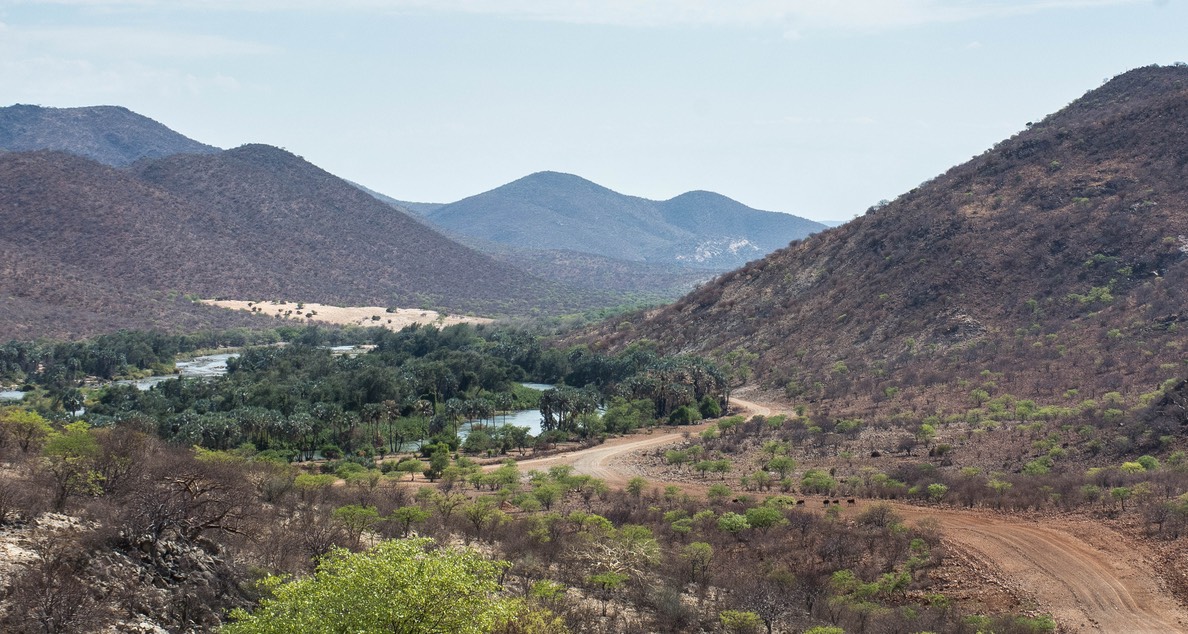
We liked being on the river. We were told that if we wanted to go across and poke around Angola for a bit, it would be safe, the fishing was excellent, and the countryside quite lovely. Well, we’ll see.
Our next plan was to travel further east sticking near the river, heading for the junction town of Ruacana. Some reports (from people with tall trucks) had talked of folks having to skip this part of the trip because low-hanging limbs were too difficult to negotiate. In checking, however, it seems some entity had come through in recent times and cleared the path; we were told we’d have no trouble getting through.
What a pretty drive; right along the river much of the way, with detours to go up and over sloping ridges and places to stop and enjoy the view. Not too many critters, only a few impala and the occasional baboon, but they were good company. From time to time we waved at Angola across the way. Eventually we reached the Kunene River Lodge, touted as a great stopping place, and spent a few days there. It was Christmas, so they were relaxed and casual — and very busy.
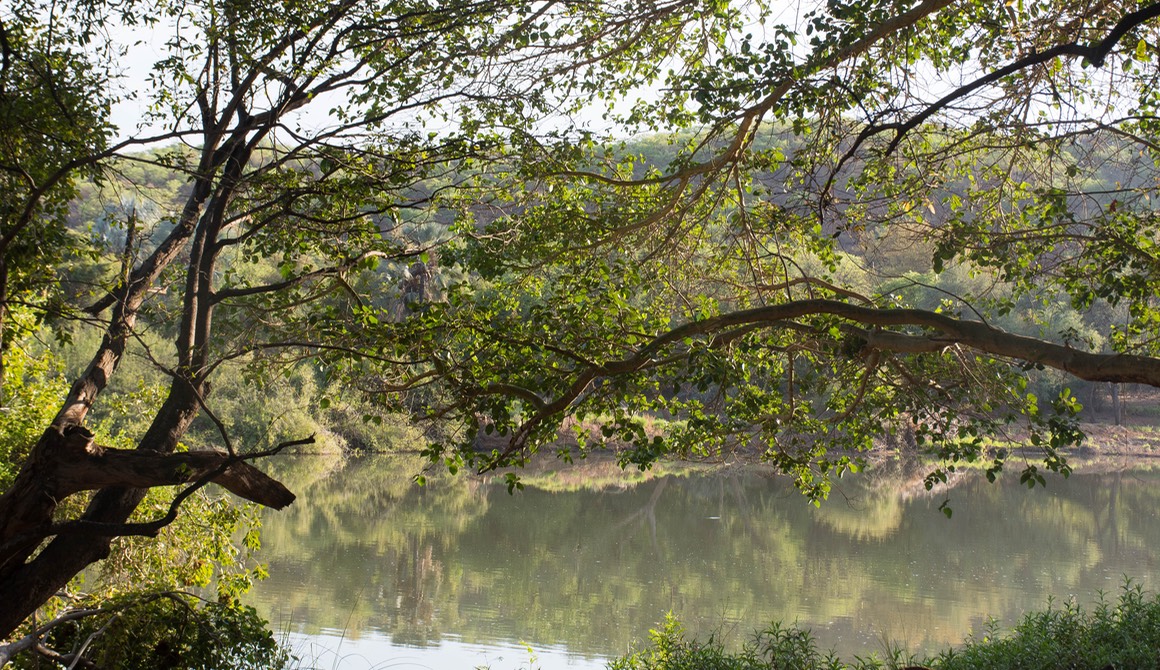
They found us a pretty little spot right on the water. We stayed as long as our food lasted; otherwise we’d probably still be there. Every day there were tremendous thunderstorms, with lots of rain, lasting maybe an hour. We got drenched running for cover. Then the sun would come out again. It was so nice, with vervet monkeys in the trees and the sun sparkling on the water. Rick made friends with a family from Windhoek, and they’ve offered to help us put together some repairs that need to be made on the Tiger. (The roads are, indeed, taking their toll.)
We left after Christmas and continued east, heading for Ruacana. As we moved along, we enjoyed watching the river; it was traveling west, to finally dump into the Atlantic Ocean at Foz do Cunene; it remains the Angolan border all the way, and is also the northern border of the Skeleton Coast NP as it approaches the coast. It’s a wide river at its finest, and we really enjoyed the ride. (If you’re having trouble figuring out where all this is, go run and get your map; we’ll wait for you.)
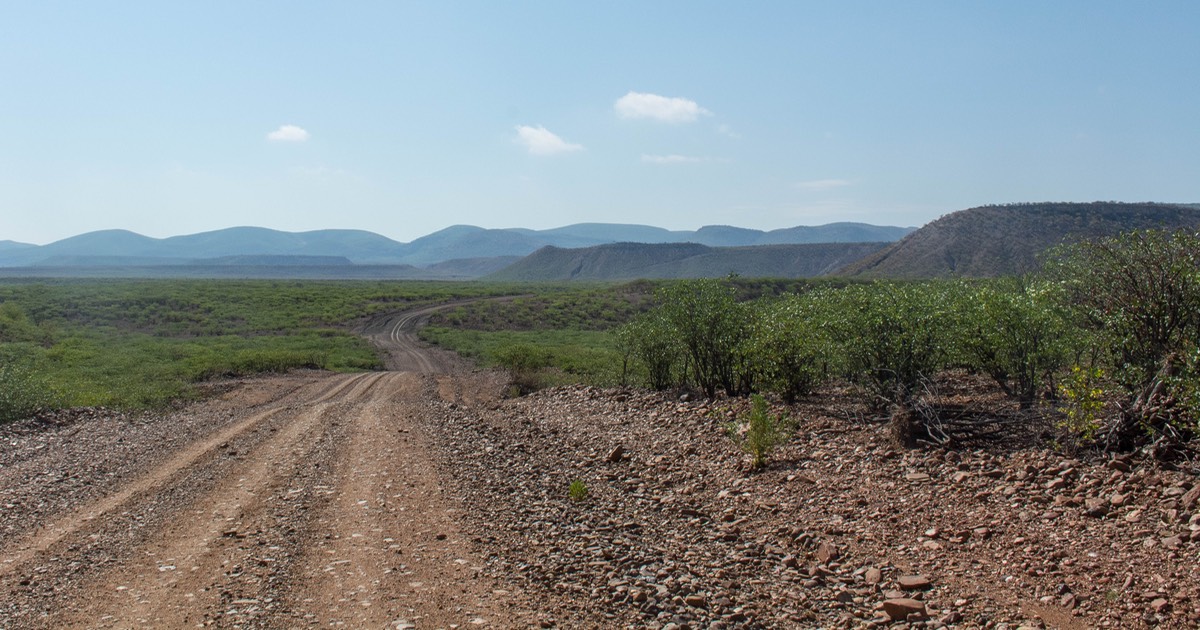
The road was rugged but lovely. We passed many local communities and individual dwellings; otherwise we were quite alone. As we approached Ruacana Falls (where there is a huge dam that supplies electricity for most of Namibia) the river became smaller. There was no water in the falls at this time of the year.
We climbed back up out of the river basin and emerged onto pavement for the first time in about 10 days, and headed back into civilization. We’d traveled almost 900 kms on gravel, dirt and rocky roadbeds. It had been a great adventure, our far northern hinterland trek, but all three of us were ready for tar.
Ruacana proved pretty unhelpful as far as food went; the fuel station seemed to be the best bet. So we filled the tank and kept moving south, toward Kamanjab. We’d decided o a return to Oppi Koppi Camping, where we had stayed before and where we knew we could settle in for a few days to regroup (and there was decent pizza to be had). There is a small grocery store in Kamanjab where we could replenish the hold; Oppi Koppi has nice spots for cleaning out the dust — and even a car wash if that seemed desirable.
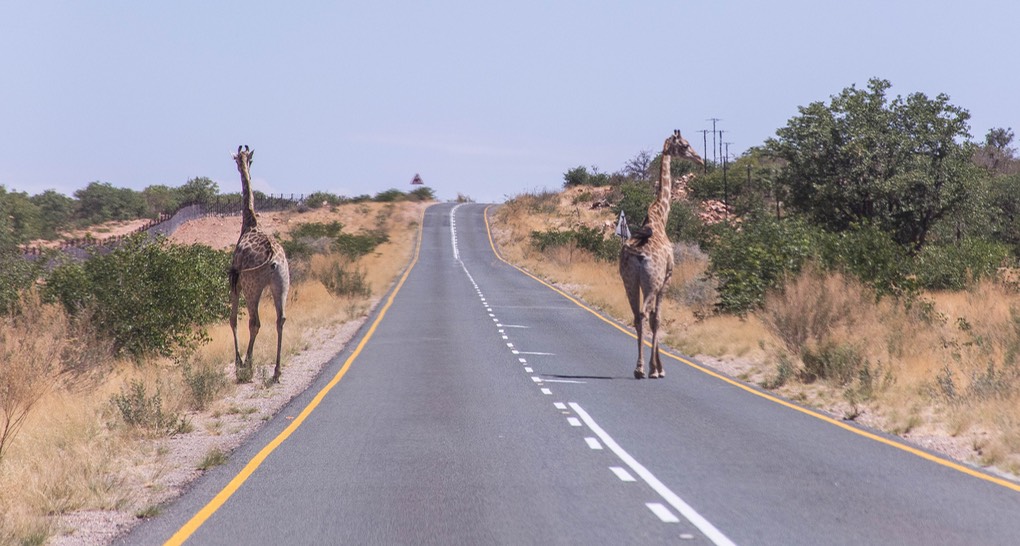
But before reaching Kamanjab, we would be crossing that damn Vet Fence, heading south. So why the fuss? They are looking for meat and poultry products. We were stopped and queried about what was in our pantry and refrigerator. It’s a bit tedious, and reminiscent of similar programs in Latin America. Typically not a big deal, unless, of course, you’ve forgotten you are getting to it. I had thought I was well prepared, but we’d expected to spend the night in Ruacanna and then didn’t so we were one night ahead of schedule and I did get caught. They gently removed a carton of eggs that I had planned to cook for dinner that night. Said I could boil ‘em, and then keep ‘em, but stop and cook them then and there? Not a chance. So we put eggs on the shopping list and kept going.
We stayed in Kamanjab for four days. We’d planned on three, but couldn’t drag ourselves away. And that was serendipitous, as our last night we met a great couple, Jim and Donna, from Halifax. We talked into the night, as we were heading off in opposite directions, and then made plans to have dinner together at Joe’s Beerhouse in Windhoek — we will overlap there for a single night before they leave Namibia and just after we arrive. Did I say serendipitous?
The next morning, we waved goodby with promises of “Windhoek!” and started further south. We’d had some plans to stop at spots we’d missed on our way north, but ultimately we knew we’d be best off if we we returned to the coast and cooler weather once again.
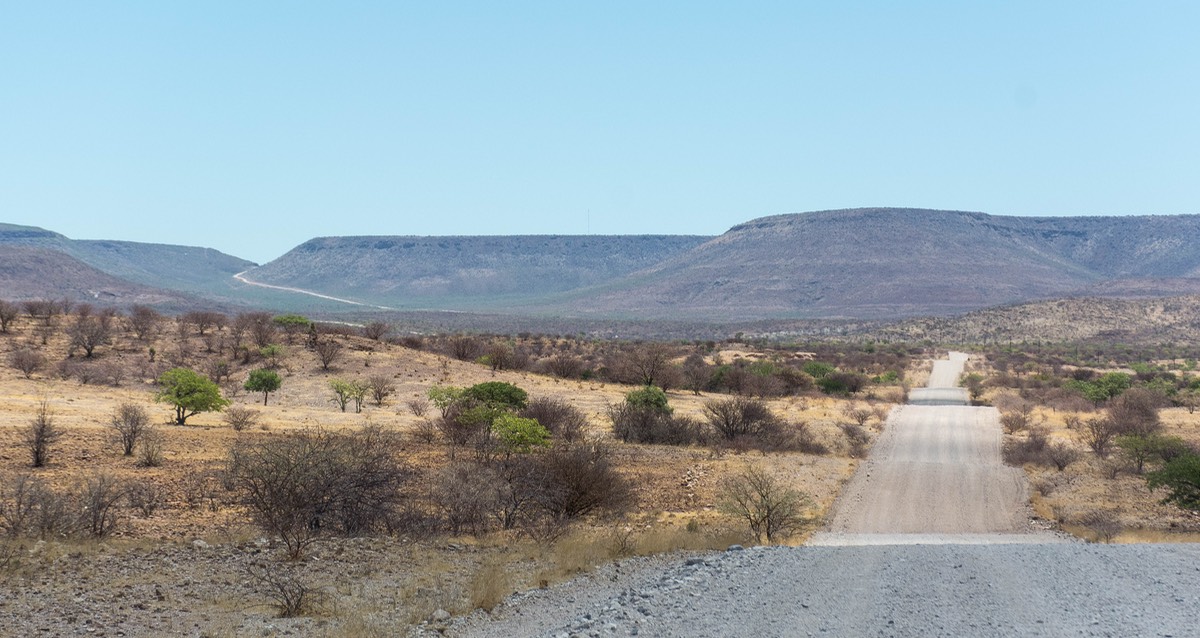
So we headed due west from Kamanjab over Grootberg Pass (1540 meters) and back into the Torra Conservancy to spend New Years, with a target of returning to Cape Cross for a few days before hitting the road east into Windhoek. It turned out to be a real mother of a road — and we promptly broke one of the hood hinges again. This has become a real problem area for us and will require a major repair soon. By now you may have noticed that this has happened a lot, so we’ll just explain that it isn’t the same piece breaking over and over again, but all four of the parts that make up the hinges for the hood taking turns breaking in a variety of different spots. We’re so used to it that it no longer merits a major Merde comment; is that a good thing?
After thoroughly examining the issue and applying a lot of duct tape to keep the hood in place, we gently kept going, knowing that we’d be on paved roads soon and this was an issue already on our Windhoek list. This was lovely country, and got even prettier as we approached and then entered the Conservancy. We found our old spot from early in the month, and settled down for another stay.
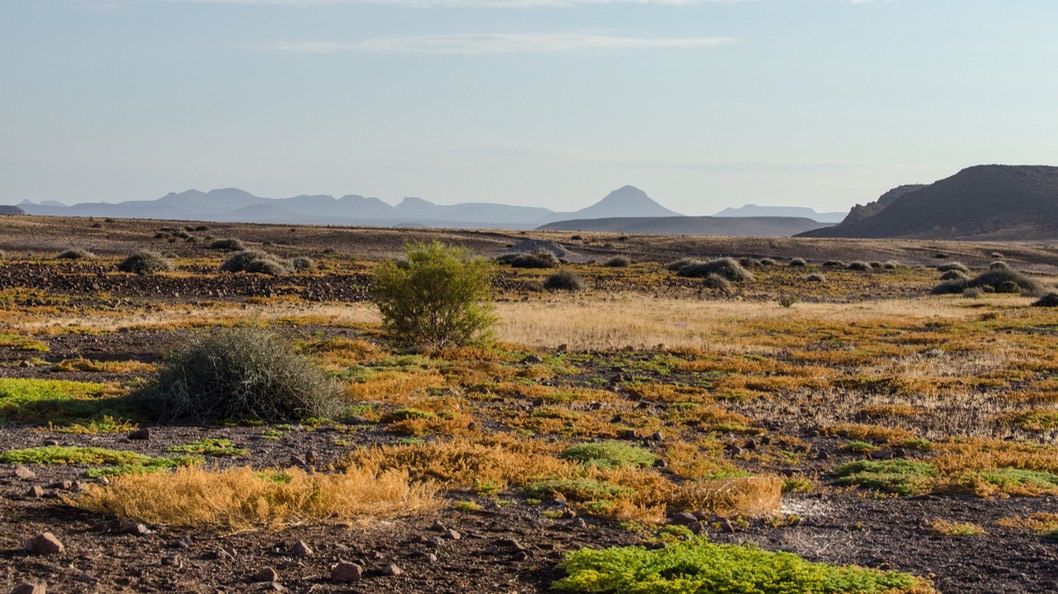
This is where the wildlife folks stopped to check on us and then moved on after wishing us a very happy new year — and reminding us that there were elephants, lions (a lioness with new cubs in particular), and rhinos in the area, to list the more dangerous critters nearby. We never saw any of these guys, but it was nice to know they were there.
The next day we gathered ourselves together, wishing we had more food on hand and no reservation already made at Cape Cross. To us, this is the most perfect spot in Namibia. Warm during the day, cool at night with a nice breeze off the ocean 100 kms to the west, a pretty and quiet area, and small critters to keep us company. And… it’s wide open and free. Oh, well.
The road to the coast took us back alongside that vet fence, into and through the Skeleton Coast National Park, past the seal colony, and to our home for the next few days, where we enjoyed ourselves. We were cool and comfy, it was sunny and warm and breezy, we were able to work on some projects and enjoy more of that local bread. We were pretty happy, actually. The campsite was filled with fishermen — the People of the Long Poles, as Rick calls them. You know, those guys who have fishing poles sticking up all over the place from their bumpers.
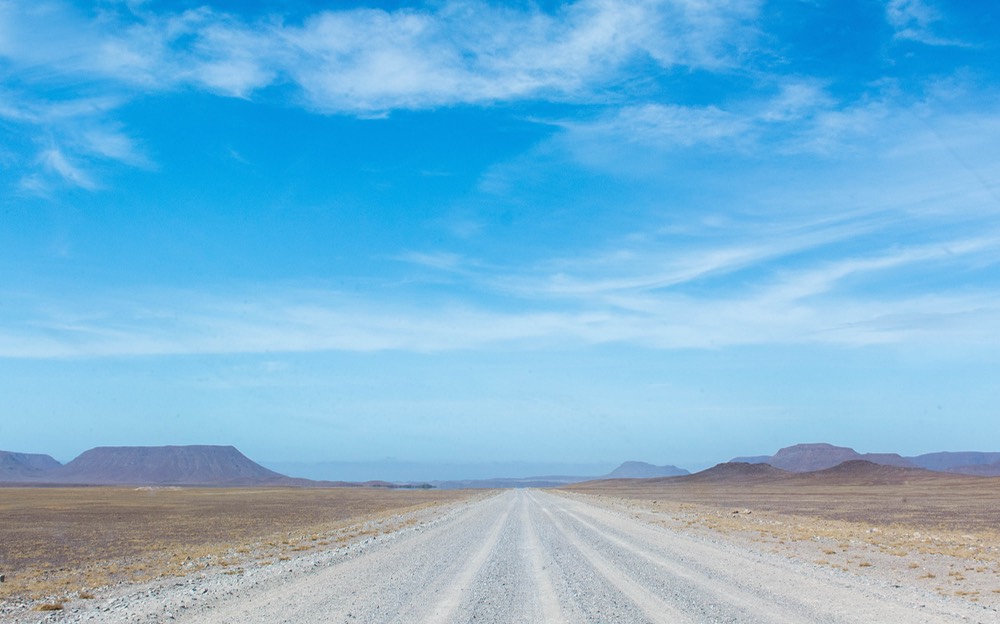
We made a trip into Henties Bay for groceries (and internet — the Lodge wifi at Cape Cross was defunct as is often the case). There was a fish and chips shop we’d not yet tried, and it turned out to be quite good — Fishy Corner, if you come through — and a homemade pies shop across the way. We’re doing fine. Oh, and Henties Bay (or Hentiesbaai on the signs) also has a rather glamorous tourist office along the road into town — but we’ve never seen it in operation in all the times we’ve been through here. The hardware store was open, though, and guess what we found — bright yellow, very strong duct tape! It now decorates the hood spectacularly. We still have a bit of the black tape left so we’re considering a bumble bee motif.
But we needed to get on up to Windhoek. We had to solve the problem of getting our Carnet sorted, and make plans for storing and working on the truck. So we spent a long day going the 500 kms between Cape Cross and our campsite in the heart of the city. During the last bit, closing in on Windhoek late in the afternoon, a person could look around and see brightly colored, multistory housing and factories, modern divided highway all nice and shiny — after all, this is the capital of the country.
And then we saw traffic slow and come to a halt in order to allow a herd of cattle to make its way across first the northbound lanes, then the grassy middle section (oops, there’s a couple of them stopped to munch), and finally the last of them crossing the southbound lanes and heading up the verge to home. We loved it. We had returned to Windhoek and to beautiful Urban Camp, with its relaxed pace and lovely setting. We’d left ourselves a little over a week to get things done and found ourselves a nice base from which to operate.
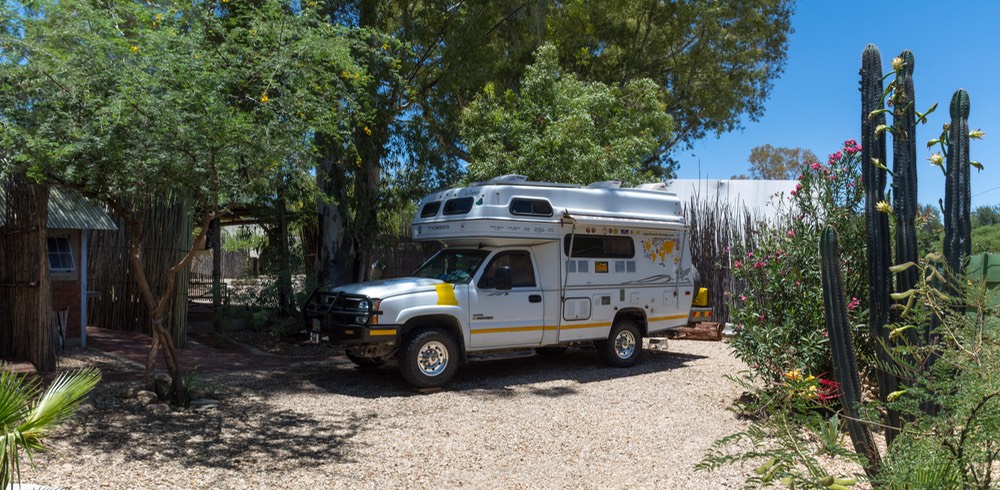
After about 6 weeks back in the States we will return to Windhoek late in February; then we will be leaving to head out for new adventures. As we prepare to say goodby to Namibia, we’ve given some thought to our time here. There’s plenty to do, and lots of places to visit, but probably 3 months was more time than we needed to allow; 6-8 weeks might have been better. Granted, we’ve not yet been to the Zambezi area (the Caprivi Strip, as it used to be called). We’ll do that later in 2019.
Namibia has lots of rugged, desolate but lovely places to visit, and we tried to see as much as we could. This, plus the great opportunities to see wild animals, make coming here an excellent choice. But if the desert doesn’t do it for you, you may get bored and move on. I loved it; Rick enjoyed himself but had a lot of pretty difficult roads to negotiate and they took their toll.
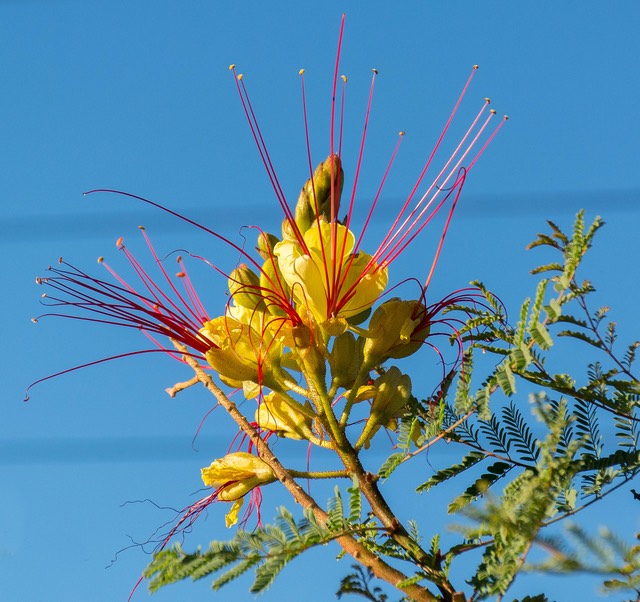
We were surprised at the percentage of protected areas here. The “biggies” — Etosha, the Namib Dunes at Sossusvlei, Fish Canyon — all are national parks. But there are many conservancies, private game reserves, and guest farms dotting the countryside. Each contributes to the overall conservation effort, which is quite extensive. We think establishing all these protected areas helps to preserve the natural environment, but it means lots of Namibian people are relying on tourism for their survival, rather than following other paths. Is this wrong? No, of course not, but a different focus than we had expected.
In some ways this country feels like part of South Africa. Many of the stores are the same and the architecture is cut out of the same mold. Many people speak English, but the “native” tongue here (apart from the many African dialects) is more likely to be either German or Africaans; in SA there is a lot more Dutch in with the Africaans (this is a generalization, so don’t hold us to the details!). Namibia was first colonized by the Germans (German South-West Africa), and then was given to South Africa to control after Germany lost it in the Treaty of Versailles, post-WWI. The South Africa whites ruled it just as they did their own country, including a very harsh version of apartheid and several episodes of what is now acknowledged as genocide. It wasn’t until 1990 that Namibia achieved its independence.
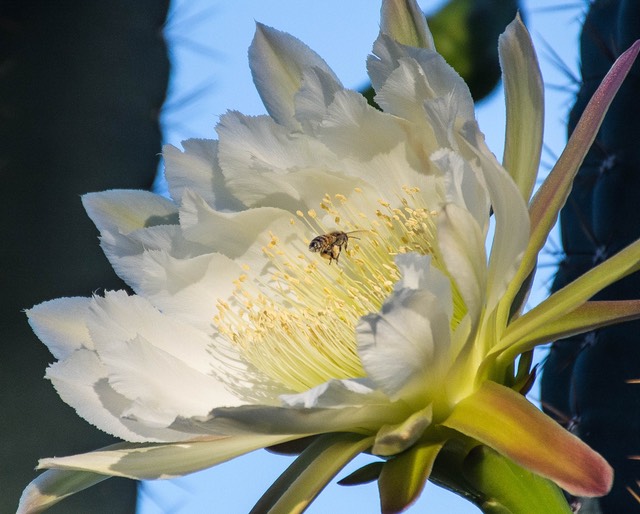
But to us, in many ways this country is a better version of South Africa. The Namibians stand tall, and based on what we’ve been told, are (after some very rough periods), running their country pretty well; they seem happy and quite pleased with life. They are forthright in conversation; seem well educated and sophisticated, and quite knowledgeable on world affairs. People greet you in passing on the streets. There is a large middle class that is doing well (we are surrounded by it here in the capital).
Of course, none of this means that trying to get something done is easy. We ran afoul of the summer holidays — starting early in December and still going strong until mid-January. Some businesses are still closed through the coming weekend. Makes it hard to organize work to be done, our carnet to be squared away, and some arrangements to be finalized before we leave in a week. Just this morning we took taxis from one office to the next — four in all — before finally locating the right place to take care of the carnet.
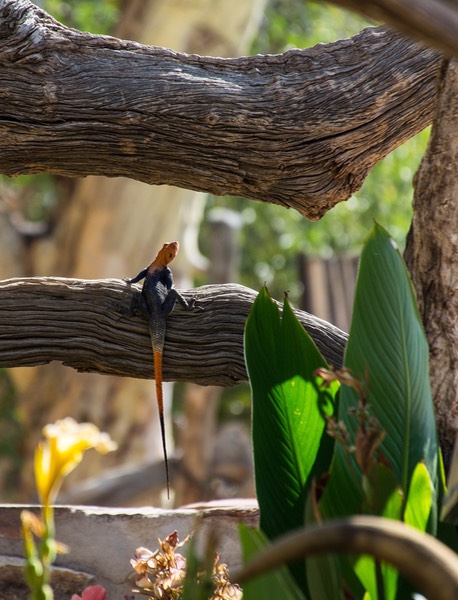
But we persevere; after all — TIA, baby!
But, we’re surely not sitting around being unhappy in our lovely site at Urban Camp, right in the heart of town and just down the road from Joe’s Beerhouse. Instead we’ve had a terrific dinner with new friends at Joe’s and, in addition to cleaning and packing, we’re spending time enjoying this pretty setting, with lots of flowers just coming into bloom and plenty of birdsong surrounding us, with even a cool lizard for company. Not too shabby, we think.If you’re on the West Coast of the U.S., and at home, we may catch up with you over the next several weeks. If not, see ya down the road!
Much love, from Rick and Kathy and the Tiger, with more yellow decorations than ever before
Go to the Photo Page to see more pictures from this story